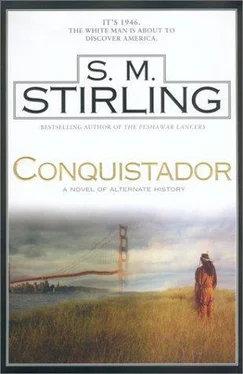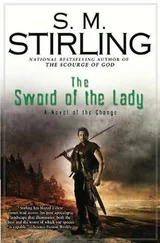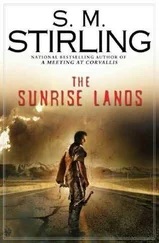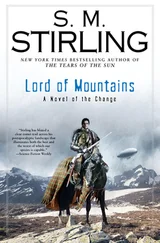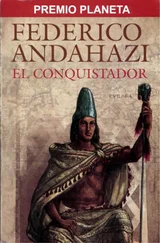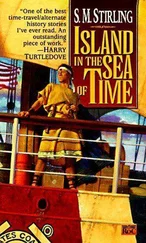S. Stirling - Conquistador
Здесь есть возможность читать онлайн «S. Stirling - Conquistador» весь текст электронной книги совершенно бесплатно (целиком полную версию без сокращений). В некоторых случаях можно слушать аудио, скачать через торрент в формате fb2 и присутствует краткое содержание. Город: New York, Год выпуска: 2008, ISBN: 2008, Издательство: ROC, Жанр: Альтернативная история, на английском языке. Описание произведения, (предисловие) а так же отзывы посетителей доступны на портале библиотеки ЛибКат.
- Название:Conquistador
- Автор:
- Издательство:ROC
- Жанр:
- Год:2008
- Город:New York
- ISBN:9781435290143
- Рейтинг книги:4 / 5. Голосов: 1
-
Избранное:Добавить в избранное
- Отзывы:
-
Ваша оценка:
- 80
- 1
- 2
- 3
- 4
- 5
Conquistador: краткое содержание, описание и аннотация
Предлагаем к чтению аннотацию, описание, краткое содержание или предисловие (зависит от того, что написал сам автор книги «Conquistador»). Если вы не нашли необходимую информацию о книге — напишите в комментариях, мы постараемся отыскать её.
1945: An ex-marine has discovered a portal that permits him to travel between the America he knows-and a virgin America untouched by European influence. 21st century: The two realities collide…
Conquistador — читать онлайн бесплатно полную книгу (весь текст) целиком
Ниже представлен текст книги, разбитый по страницам. Система сохранения места последней прочитанной страницы, позволяет с удобством читать онлайн бесплатно книгу «Conquistador», без необходимости каждый раз заново искать на чём Вы остановились. Поставьте закладку, и сможете в любой момент перейти на страницу, на которой закончили чтение.
Интервал:
Закладка:
There are vast differences in Central and East Asia. The Alexandrian empire and its neo-Greek successor states remained strong in Bactria—the settled, agricultural part of southern Central Asia—and assimilated the sedentary Iranian peoples. The north-Iranian nomads, blocked and harassed by the Greeks in Bactria, the southern Ukraine and cis-Caucasia, turn east instead of west—in our history they eventually moved as far as central Europe, pushed and followed by the Turkic, Ugrian (Hungarian) and later Mongol-speaking tribes.
In the Alexandrian timeline the migrations went the other way. The northern Iranian nomads first moved east over the Tien Shan and pushed the Tocharian-speakers of the Tarim Basin [1] Tocharian is the name given to a group of Indo-European languages spoken in what is now Chinese Turkestan/Sinkiang from the Bronze Age through the early medieval period. The Tocharian speakers were the easternmost of the Indo-European peoples, and their tongue (rather oddly) shows a closer kinship to the western Indo-European languages (Celtic, Germanic, Greek, Italic) than it does to the Indo-Iranian group. Recent archaeological work in the Tarim, whose climate is uniquely suited to preserving bodies, has shown that the Tocharians were European in appearance as well—tall, narrow-faced people with light complexions and often blond or red hair; in fact, they looked rather like Central or Northern Europeans. In our history they were overrun and assimilated by Turkic-speaking peoples, the ancestors of the present Uighur population of Sinkiang.
and Shansi directly east, into Manchuria, Korea and northeastern China. Then they followed and bypassed them in waves, taking over outer and inner Mongolia, then invading China proper.
Korea-Manchuria-northeast China is held by a number of Selang-Arsi kingdoms, essentially Tocharian, but with substantial influence from the Chinese substrate. The rest of China as far south as the southern fringes of the Yangtse valley is occupied by mixed peoples speaking Iranian languages. Mongolia, Inner Mongolia, Sinkiang and the steppe zone as far as the Tien Shan are inhabited by North Iranian nomads, and farmers in the oasis zones. The Mongol and Turkic peoples were swallowed up by the Tocharian and Iranian migrations.
Europe was always a backwater to the Alexandrian Empire, although Greece remained culturally important. Italy, southern France (roughly Provence), and Spain are post-Greek—small kingdoms and city-states, civilized in a provincial fashion.
In northern Europe, without the Romans to intervene, the Germanics more or less completely displaced the Celts; the destructive passage of the Cimbri through Gaul around 100 B.C., and their settlement in the Garronne estuary, began the obliteration of the western Celts.
The area from Ireland to the mouth of the Danube is occupied by various Germanic kingdoms and tribes—all barbarians and preliterate save for a narrow fringe along the edge of the post-Alexandrian zone; occasional folk-migrations and conquests along the Mediterranean shore have been of little long-range consequence, since the invaders were invariably absorbed by the higher culture.
In eastern Europe, the Slavs were weakened by their clashes with the Alexandrian Empire and its successors; this largely prevented the Dark Age migrations out of the urheimat in southeastern Poland/northwestern Ukraine, which in our history carried the Slavic languages deep into the Balkans and far into Asia. Instead, the Balts supplanted the Slavs in a long series of folk-movements, occupying the zone east of the Germanics and stretching to the upper Volga; however, except for a few of their southernmost kingdoms, they remain even more backward than their western neighbors.
New Guinea and Australia-New Zealand are roughly as in our history—prediscovery—except that the New Virginians have begun making settlements there.
North America was neolithic or hunter-gatherer when the Gate opened in 1946. Some early state-level societies had emerged in the Mississipi-Ohio valley, and the Iroquoian peoples had mostly replaced the others in the northeast and middle Atlantic states. On the Pacific, the Potlatch tribes—the Haida and their relatives—had the most elaborate culture, and had spread further than in our timeline, reaching down the Oregon coast. They had some contact with the Chumash, the most sophisticated of the Californian peoples.
The Aztec and Inca hegemonies had long since fallen apart in 1946, but their areas remained civilized and had advanced into a full Bronze Age, with extensive use of bronze weapons and tools, and both had developed genuine writing systems ultimately derived from the Maya syllabic script. Politically they were chaotic, with many small kingdoms; they remained handicapped by the lack of horses and other draft animals. The Nahuatl and Quechua languages had spread to most of those areas, reducing their linguistic diversity.
All this was thrown into chaos by the epidemics which accompanied the opening of the Gate, and which were renewed and worsened by the beginning of trans-Pacific trade by both the New Virginians and various East Asian peoples in the early 1960s.
By the twenty-first century, the population of the Americas had declined by about 90 percent from its peak in 1946, from around 35 to 45 million to about 3 to 4 million total, with less than half a million in North America above the FirstSide Mexican border. The percentage decline is roughly similar to that which the Americas suffered in the century after Columbus in our history. Losses were worse than that in the areas along the Pacific coast of North America, where the indigenous populations effectively ceased to exist.
There were also ecological upheavals, partly through the inadvertent introduction of new weeds and microorganisms—this begins almost immediately, as the horses brought over for the first expedition to the goldfields scatter grass seeds in their dung. Within a few years, even more radical changes result from John Rolfe’s program of deliberately introducing African and Eurasian animals and plants over huge areas. This is comparable to the post-Columbian exchange in our timeline, but faster and larger-scale, since it is conscious rather than inadvertent and the New Virginians have much better transportation technology than Renaissance-era Europeans.
Remnants of the western tribes move east, encouraged by the Commonwealth authorites. With them go horses, and via trade, steel tools and trade firearms (replica flintlocks).
By the twenty-first century, there is a horse-nomad culture on the Great Plains and in the southwestern basin and range area; most of them are hunters, in a rather close analogue of the mounted buffalo hunters of our timeline’s Old West, but some have become herders of cattle and sheep as well. Technology transfer is rather swifter; for example, most tribes learn to use wheeled carts and saddles with stirrups almost as soon as they adopt the horse.
The higher neolithic farming societies of the central and eastern parts of the continent collapse back into a simpler village-based culture under the hammer of the plagues, losing most of their complex social hierarchies. As yet they have had little contact with the New Virginians, except in the immediate vicinity of their trading posts and small settlements on the east coast.
By 2009, the New Virginians are dominant all along the Pacific coast from southern Alaska to Baja, and are steadily pushing inland as their numbers increase. They have also colonized Hawaii (the survivors there migrated to Tahiti by agreement) and are making a beginning in Australasia.
There are surviving Mexica-Zapotec-Mayan city states in Mesoamerica, and ditto in Peru, in contact with the New Virginians, trading with them and learning a good deal. The New Virginians have trading posts there, and small colonies on the eastern coasts—at the mouth of the Rio de la Plata, Rio, the Caribbean, and the Atlantic coast of North America.
Читать дальшеИнтервал:
Закладка:
Похожие книги на «Conquistador»
Представляем Вашему вниманию похожие книги на «Conquistador» списком для выбора. Мы отобрали схожую по названию и смыслу литературу в надежде предоставить читателям больше вариантов отыскать новые, интересные, ещё непрочитанные произведения.
Обсуждение, отзывы о книге «Conquistador» и просто собственные мнения читателей. Оставьте ваши комментарии, напишите, что Вы думаете о произведении, его смысле или главных героях. Укажите что конкретно понравилось, а что нет, и почему Вы так считаете.
